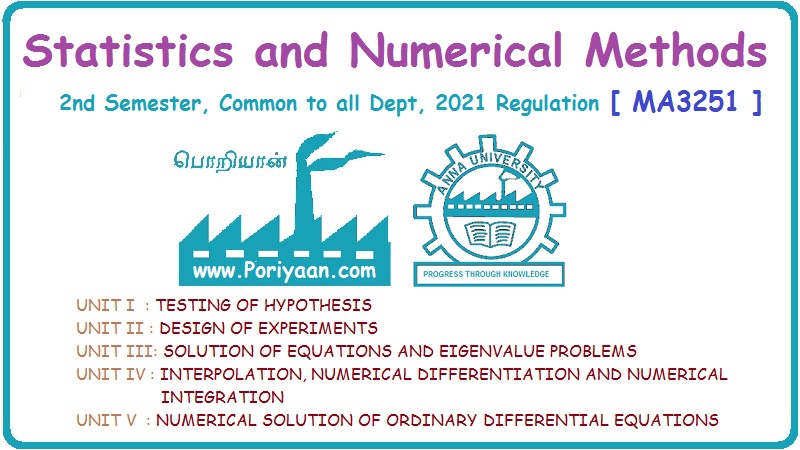Statistics and Numerical Methods: Unit III: Solution of Equations and Eigenvalue Problems
Short Questions and Answers
Gauss-Jocobi method & Gauss-Seidel method
Statistics and Numerical Methods : Unit - III : Solution of Equations and Eigenvalue Problems : Short Questions and Answers
SHORT QUESTIONS AND ANSWERS
1.
Write the sufficient condition for Gauss-Seidel method and Gauss-Jacobi method
to be converge. [AU A/M 2018 R08, R13SNM] [A.U A/M 2019 (R17)] [A.U N/D 2020
(R17), A/M 2021 (R17)]
Solution:
The
coefficient of matrix should be diagonally dominant.
2.
Gauss elimination and Gauss-Jordan are direct methods while and ....... are
iterative methods.
Solution:
(i)
Gauss-Seidel method; (ii) Gauss-Jacobi method no
3.
Give two indirect methods to solve a system of linear equations. [M.U. April,
2001]
Solution:
(i) Gauss-Jacobi method; (ii) Gauss-Seidel method
4.
Solve the system of equations
2x-3y+20z
= 25
20x
+ y 2z = 17
3x+20y
- z = -18 by Gauss-Jacobi iteration method.
[Only
two iteration]
[A.U.
Nov. 1996]
Solution:
As the coefficient matrix is not diagonally dominant as it is, we rewrite the
equation.
20x
+ y 2z = 17; 3x + 20yz = -18; 2x - 3y + 20z = 25
Now,
the diagonal elements are dominant in the coefficient matrix, we write x,y,z as
follows :

Let
the initial conditions be x = 0, y = 0, z = 0
First
Iteration :

Second
iteration :

5.
Compare Gauss-elimination and Gauss-Seidel methods.
(or)
[A.U
CBT A/M 2011]
State
the merits and demerits of elimination methods and iterative methods for
solving a system of equations.
Solution
:

Gauss
elimination method
1.
It works on the basis of elimination of variables
2.
These can be used for small number of co-efficients.
3.
Its performance is affected due to round-off errors.
4.
Direct method for solving linear simultaneous equations.
5.
It gives the exact solution in finite number of steps.
Gauss-Seidal
method
1.
It employs initial values and iterates to obtain refined estimates.
2.
These can be used for large number of co-efficients.
3.
There is no round-off error problem. Error is controlled by number of
iterations.
4.
Iterative method for solving linear simultaneous equations.
5.
Successive approximations get the solution.
6.
Compare Gauss-Jacobi and Gauss-Seidel methods.
Solution
:

1.
Convergence rate is slow
2.
Indirect method
3.
Condition for convergence is, the coefficient matrix is diagonally dominant
Gauss-Seidel
method
1.
The rate of convergence of Gauss-Seidel method is fast, roughly twice that of
Gauss-Jacobi.
2.
Indirect method
3.
Condition for convergence is, the coefficient matrix is diagonally dominant.
7.
Is the iteration method, a self-correcting method always? [M.U. Oct. 1997]
Solution:
In general, iteration is a self correcting method, since the round off error is
smaller.
8.
Distinguish between direct and iterative methods of solving simultaneous
equations. [A.U Tvli M/J 2011] [A.U A/M 2019 R-17]
Solution:
There
are numerical methods of solving simultaneous equations. They are particularly
suited for computer operations. These numerical methods are of two types,
direct or iterative. Direct methods involve a certain amount of fixed
computation and they are exact solutions. Iterative or indirect methods are
those in which the solution is got by successive approximations. But the method
of iteration is not applicable to all systems of equations.
9.
When will iteration method succeed?
Solution:
In
order that the iteration method may succeed, equation of the system must
contain one large coefficient (much larger than the others in that equation)
and the large coefficient must be attached to a different unknown in that
equation. This requirement will be got when the large coefficients are along
the leading diagonal of the matrix of the coefficient.
10.
Why Gauss-Seidel method is a better method than Jacobi's iterative method ?
[A.U A/M 2018 R-13 NM]
Solution:
Since
the current values of the unknowns at each stage of iteration are used in
proceeding to the next stage of iteration, the convergence in Gauss-Seidel
method will be more rapid than in Gauss-Jacobi method.
11.
Distinguish between direct and iterative (indirect) method of solving
simultaneous equations.
Solution
:

Direct
method
1.
We get exact solution
2.
Simple, take less time
3.
These methods work efficiently upto 100 coefficients.
4.
Direct method's performance is affected due to round-off errors.
Iterative
method
1.
Approximate solution.
2.
Time consuming, laborious.
3.
These methods can be used for
4.
large systems of equations (more than 100)
5.
There is no round off error problem.
12.
Write down the iterative formula of Gauss-Seidal method. [A.U N/D 2014]
Solution:
Consider
the system of equations,

13.
Name the two methods to solve a system of linear simultaneous equations. [A.U
M/J 2016]
Solution:
(i)
Direct method
(ii)
Indirect method (or) Iterative method
14.
Which of the iterative methods for solving linear system of equations converge
faster? Why? [A.U
A/M 2015 R-13] [A.U N/D 2016 R-13]
Solution:
Gauss-Seidel
method is solving for linear system of equations converge faster. In this
method the rate of convergence is roughly twice as fast as that of
Gauss-Jacobi's method.
15.
What are the various methods of solving simultaneous linear equations? [A.U N/D
2020 (R-17)] [A.U A/M 2021 (R-17)]
Solution
:
(1)
Direct method
(a)
Gauss-Elimination method
(b)
Gauss-Jordan method.
(2)
Iterative method
(a)
Gauss-Jacobi method
(b)
Gauss-Seidel method
Statistics and Numerical Methods: Unit III: Solution of Equations and Eigenvalue Problems : Tag: : Gauss-Jocobi method & Gauss-Seidel method - Short Questions and Answers
Related Topics
Related Subjects
Statistics and Numerical Methods
MA3251 2nd Semester 2021 Regulation M2 Engineering Mathematics 2 | 2nd Semester Common to all Dept 2021 Regulation
